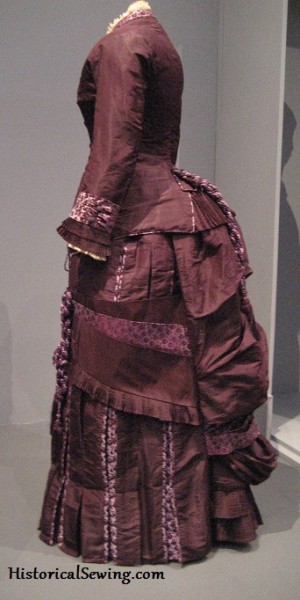
Ahh.. the Victorian Bustle Era. It’s so pretty! And aside from the huge poufy sleeves of the 1890s, it’s what most people think of when they hear “Victorian.” It’s the trimming. The opulence. The expensive laces. The multitude of fabrics – all on the same gown.
But did you know there are three distinct varieties that reside within these two decades?
Yep. 1871 looks like a distant relative to 1880 fashion. And by 1888 –that child resembles the grandmother, but not quite….
Let’s explore why these cousins kiss – and don’t.
From about 1868-ish to 1876 is known as the First Bustle Era, or Early Bustle, or simply 1870s Bustle. This is all about the poufs, the ruffles, the girly-ness.
Years from 1877 to 1882 fall into the Natural Form Era – “natural” as in the wired bustle contraption was left hanging in the closet and was replaced with a small pad resembling a woman’s “natural” curves.
Late Bustle, 1880s Bustle or Second Bustle Era came back strong in 1883 and lasted until 1889 when women had had enough of making their back side look disproportionally huge with the rest of body. The bustle was thrown out nearly overnight.
Early Bustle Era – 1868-1876
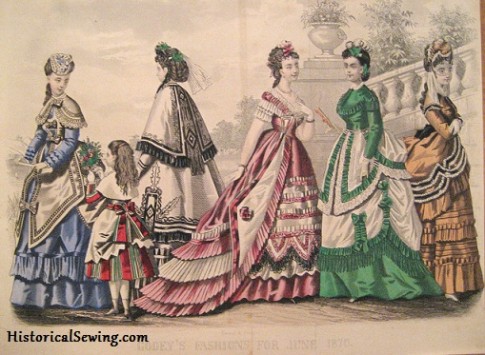
To study a fashion era, you must always start from where the styles are coming from. Fashion doesn’t change overnight. It’s a progression of change, pushed by influencing tides from celebrities and fashion designers.
Charles Worth, that celebrated King of Couture, felt the bustle coming long before anyone else. You can witness that by his addition of overskirts in the mid-1860s.
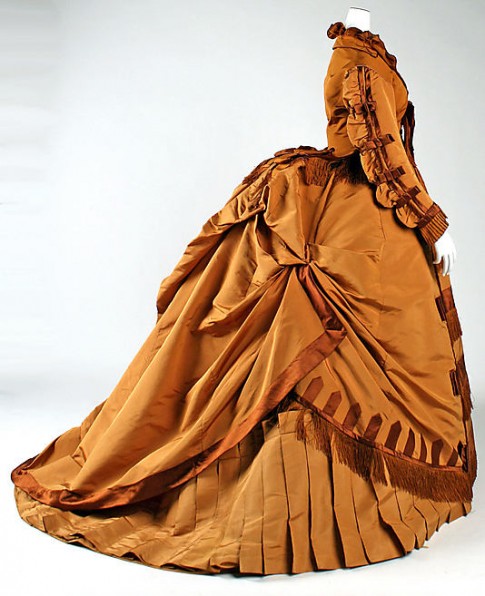
Starting with the elliptical hoop in the mid-to-late 1860s, we see the hoop start to collapse, or rather get smaller. (Guess they were done with squeezing through doorways!) Knee length overskirts were already popular so they stayed on top of the long skirt.
Now the skirt was already angling to the back with the elliptical shape. As the hoop width was reduced, they kept the angle towards the back. Well, what happens when you squeeze the sides of a hoop skirt but still want that back part? You pouf it up of course! 😉
The elliptical shape went down to a full A-line shape with the overskirts, and eventually the foundation skirt, being puffed up at the bum area.
Great… Now we need a new wired contraption to hold all that fabric up back there! So rises the Great Bustle! Yay!! (See? It all comes back to the silhouette foundation.)
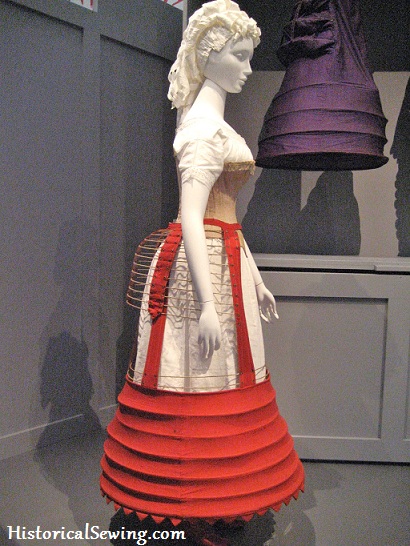
By now, thousands of households had sewing machines. So what would a woman at home with a new device capable of finishing a dress in only a day or two do with it?
TRIM! Trim the H-E-Double Hockey Sticks-LL out of the dress!! That’s what. lol
So if anything worth remembering about the 1870s Bustle is that there is TONS.OF.TRIM.
- Ruffles
- Puffs
- Ruffles with puffs
- Puffs with ruches on top, on bottom
- Ruffles on the sleeve cuffs, on the skirt, under the skirt, on the petticoats to hold out the skirt.
- And don’t forget the fabric bows.
- The braids
- The laces
- And when you’re done with that – layer all of the above. 😉
The designs, although now covered with self or coordinating fabrics and laces, stayed as they had in the 1860s – symmetrical. Both sides of the dress looked the same. Until, of course, they got bored of that and decided to play with lines of design. But that’ll come later….
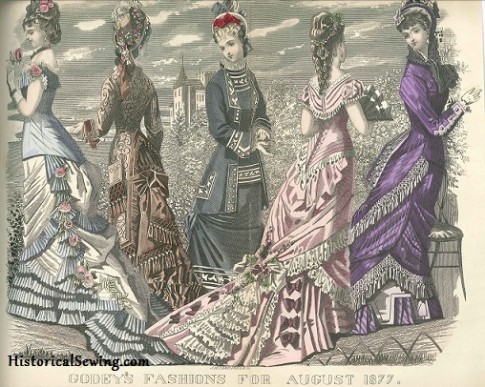
By the mid-1870s you can see the width of the skirt has narrowed some. (They simply took the hoop wires out of the bustle hem.) They also put on more trim. They are trimming the trims now! They also got crazy with trains.
But you can see from the 1877 plate above that the trims are still placed symmetrically. Yep. That’s important when looking at the differences between the bustle eras.
Well, at some point they got tired of all that skirt weight (but apparently not the trims), so they started leaving the bustle at home. Oh, it feels so good to sit back against the chair again! And this is the transition to the next fashion….
Natural Form Bustle Era – 1877-1882
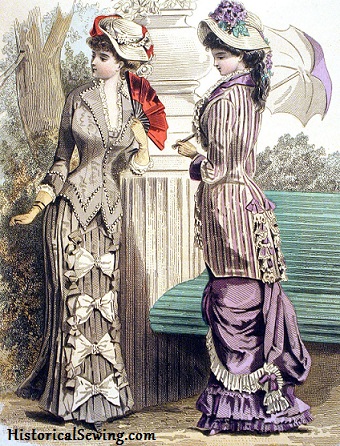
By the late 1870s the skirts were slimmer and only to get even tighter around the legs in a few years. The main skirt support was a small pad at the back and a petticoat or two. I suppose if you have enough “natural padding” the pad can be left off altogether.
Overskirts were tighter around the foundation skirt and fancy drapes in the back were appearing in all sorts of complicated shapes. Bodices were tightened and lengthened around the non-bustle skirts into a cuirass bodice – a shape that mimics the long corset shape.
Styling was very much coming from the earlier puffy shapes but was now looking better shaped to the figure. Slim was in!
This era also created what we know as the Princess Dress. Or rather, it was a full-length dress with princess seams to fit the figure and no waistline seam. The long lines emphasized height and skinniness (if you can imagine that in the Victorian years!). The Dressing Gown became uber popular.
Vertical lines down the whole body gave the awesome idea to start trimming even more on the various angles created in the skirts. Many, many gowns of this time were loaded with gathered up fabric. Self-fabric strips (more trim!) were gathered up and sewn on vertically to emphasize that long look.
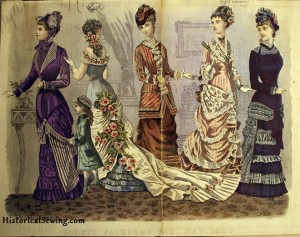
Now, this period was still focused on skirts. And hips – the Victorian hourglass shape. So in the early 1880s while still only wearing the bum pad, they decided wide hips ruled. (Oh, how I love thee!)
The overskirt draperies were split down the center front and pulled up over the hips. Front aprons were pulled back to widen that hip area. Add fringe and flowers to top it off.
Apparently you can only increase the hip width so far without looking like Marie Antoinette – no wonder we call 18th C. side hoops “panniers”! – It was a term created by the Victorians circa 1880. So here comes the next change…
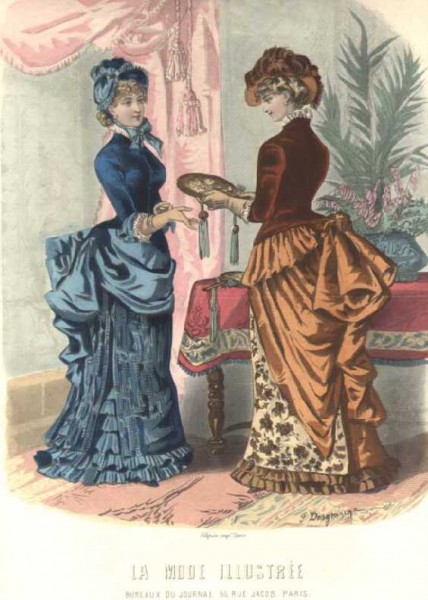
They pulled up those front aprons so much that all that fabric ended up piled on the back side again. “Hey! We need to support all this. What about those old wire contraptions at the back of the closet?” Which leads us to the Second Bustle Era.
Late Bustle Era – 1883-1889
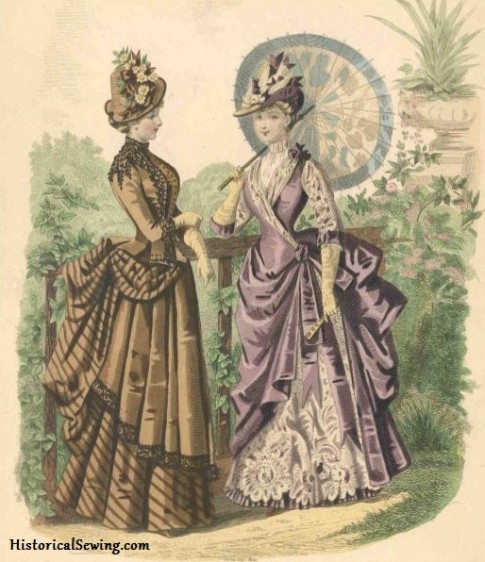
By this time, the bustle became the affectionate “lobster tail” as it kept the skirt front smooth but helped support the back poufs. That back side became HUGE.
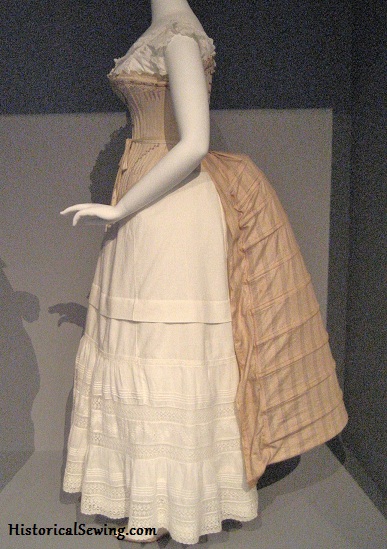
You might know the 1880s Bustle as “fashion of the Wild, Wild West.” It was fashionable yet conventional, and they had left all the frou-frou of the 1870s behind. Instead, they decided to play with style lines of the skirts by moving the overskirt layers off-center. It was all asymmetrical, baby!
Tailoring was especially noticeable on these dresses. The fit was very fine. The fabrics were high-end wool, and satins –many times combined. Necklines were high to the neck. Sleeves hugged the arm showing minimal decoration.
By nightfall, arms were fully exposed with perhaps only a flutter or two of lace attached to the bodice armhole.
It was all refined and elegant. No more foofy-ness from childhood. However, laces were widely popular and hung in graceful drapes in-between fabric panels of the skirts.
The last hurrah came around 1889 when sleeves started to pouf a fit at the top. This, they decided, was much easier to maneuver than large, bustled skirts…. Little did they know that in just a few years they’d have to slide sideways through the door because of their enormous sleeve width. But that’s a topic for another day….
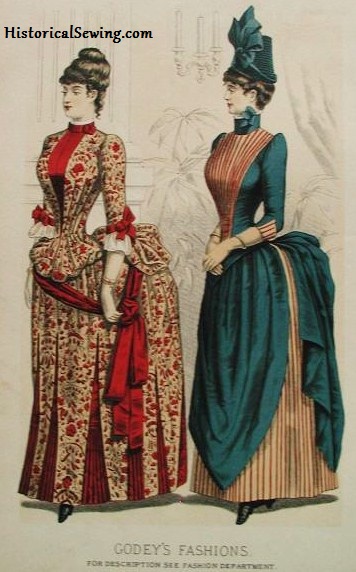
Which Bustle Era do you gravitate to – the 1870s for its puffy skirts, the Natural Form for its slim silhouette, or the 1880s for the tailored appearance?


Lovely summary! I have access to an original, 1880s “perfection tailor system” set of card templates and instruction booklet (like this, but older), and am planning a new project around it. I’m drawn to natural form this time, but am having a difficult time settling on a design. There are just too many delicious fashion plates from which to draw inspiration – would that all of life’s problems be this delightful!
Those templates are awesome!
Jennifer,
Are you familiar with the movie, “The Inheritance”, based on Louisa May Alcott’s book of the same name? It is one of my all-time favorites. The movie is set in Virginia in the late 1800’s and I have noticed the lovely BUSTLE gowns the ladies wear in it! I’m wondering if the costumes are authentic, or just an attempt like in other shows.
Thanks for your opinion!
SARAH
Wow! I just love your website and all the information. You make even the most boring little details memorable and amusing. Thanks. I’m in the process of producing a Vintage/Bridal fashion show from 1860 to 1960….what was I thinking! Anyway, we have acquired lots of vintage wear but are having to build the 1860s to 1900s our selves. Apart from acquiring patterns on line do you have any suggestions for acquiring the underpinnings such as the lobster tail bustle? Thanks again for all the encouragement you give everyone. You can tell I am personally hinting for some myself.
Great Article! I was familiar with the styles but I make a point now to read everything you post, since I am about to begin my costuming adventure… finally. 😛
My favorite styles actually run from 1877 – 1889. 🙂
I think I like the late bustle era most (from the examples shown). I like the ‘apron’ style overskirts. Also the waistline height would be more flattering for me.
This article is great! I have to mention, however, another difference between the two bustle eras – the outward slope at the back of the dress. 1870s dresses seem to usually have more volume at the bottom of the back of the skirt, whereas the back of the 80s bustles usually went straight down or sometimes went in.
Thanks, Jennifer – – I never knew the difference, and your historical evolution makes is all very clear. THANK YOU, once again for your brilliance !
I LOVE the article Jennifer. I’ve been studying and studying books and just wasn’t getting the changes between eras. Your dates are going to help me immensely as I get tired of saying 1870’s and knowing there are two different types of dresses but didn’t know how late in the 70’s the 1st bustle went. The explanations are GRAND. Now to the question. I have such challenges, I LOVE the look of the bustle eras (especially the early and natural form) but I’m not a trim and frills girl. So I’m kind of pushed to the late or 2nd bustle period. Mine are always kind of plain. I LOVE the look, just can’t bring myself to wear it. Maybe one day I’ll get into all the fru fru.
You can still make bustle dresses, Paige, and not make them froufy. Although, you’ll probably have to stretch yourself on the trim thing. Bustles, in both decades are full of trims. Trim is what makes a bustle dress. Even a narrow knife pleated ruffle at the hem will help with the look. If you love the bustle look, simply pick up that next project and go for it. You can do it!
I’m a robust woman myself and I can understand the concern. I don’t care to wear sleeveless or almost sleeveless outfits. My thought would be to make pair of sleeves in a a natural color mesh or net material that come down about half way my upper arms. I would then edge the hem and last inch in the period style. In the WWW look, I think I would embroider something like the chevron or scoop design in beads. This would give the illusion of the look yet cover the arms.
That’s a great idea! And very period correct too. 🙂
Being a larger,more robust lady and well over a young maiden, I would like to know what the styles would be for someone larger and older than the diagrams show. These dresses are beautiful, but they always show a young girl with no waist!! When I wear an evening gown with off the shoulders and all of the hoops, I look ridiculous. I feel elegant and beautiful, until I look in a mirror or see a photo. (I try not to look in the mirror or at photos, so I don’t ruin my feeling of beauty). However, there must be something written out there for the larger older woman, that isn’t all in black and no fashion. I have made a number of 1800’s dresses and they turned out gorgeous but I still don’t think they’re quite appropriate for me. Can you give me a guideline where I can look. I’ve tried online but there doesn’t seem to be much written about it. Thanks for a great site.
Deb
I appreciate your gumption to make & wear the fashion despite your hesitations. And it’s true, as women aged they no longer needed to wear the top fashions to attract a husband. One suggestion is for you to go with the “dinner dress” styles of bodices with cut out necklines but covering the shoulders and arms. Who’s to say you can’t dance when your shoulders are covered? My best thought would be to examine photographs of real people with particular attention paid to the matronly women. Their fashion may be slightly behind the times but it’s still reflective of the period. Start with The Daguerreian Society http://www.daguerre.org/ and even Pinterest. It’s a on-going study. Please know you’re not the only one with this issue.
Warm regards,
Jennifer
Great article! I remember giving my sisters a mini lecture on the progression of the 1860s-80s, but not in such good (and entertaining) detail!
I love all three eras for various reasons, but the Natural Form seems to be the best of all of them for me. I don’t have to spend a bazillion hours on trimming trims like the Early Bustle, but sometimes the Late Bustle with the huge bustles and talls hats can look a bit…ricidulous (but it’s growing on me because of the tailored look of it!). I would imagine being born in the late 1860s would be quite the train ride in terms of fashion.
Also good to know that the Natural Form era liked hips! That’s about all I have working for me!
A wonderful article pointing out all the differences in the bustle eras. I never knew what the differences were. I would be a natural form bustle person. I will need to look at the patterns on Truly Victorian and see which one I think would work for your class. Do you still have space available? I’m trying to work through timing issues with my employer. Thanks!
We still have room in the class for you Laurie! And it’s all done online so you can work through the sewing steps on your own time throughout each week. We’ll connect in the Facebook group whenever we each get a chance to pop in (I’ll be there quite often to respond to questions and comments.)
For the patterns, I’ve specifically pulled a basic underskirt, overskirt and bodice pattern set for each of the eras, so the lessons will have a structure that’s applicable for everyone. You won’t have to agonize over which patterns to get. The sets are arranged for you. 🙂
Hi Jennifer.Thanks for the articles on the bustle eras.I am reading and learning so much.Thanks again.Took sometime away from my meetings to read. Have a great day.
The other thing I’ve noticed between the two bustle periods is the bodice shapes, particularly in the waist, are different.
Early bustle sometimes still has the slightly dropped shoulder of the 60s and waist is natural – the deep V front and back having largely disappeared.
Then we get the long elongated Cuirasse bodice of the Natural Form period and then the bodice in the second bustle period is long and slender with a deep V though now instead of coming from the natural waist as it was in the late 50s and into the mid 60s, it comes from the hips.
I think my favourite is the Early Bustle where its still partly a 60s style: 68-71. I also do like the natural form period – that was my first foray into Victorian of any kind. Second was an 1840s dress and now I am fairly firmly entrenched in the 68-71 period. I have two gowns planned to be made and completed by Christmas. One in Chocolate brown and “pearl” cream and one in Indigo blue and Wedgwood blue.
Thank you! Thank you! Thank you!
I *think* I finally get it. 🙂
Thank you for the information on the changes and differences between the bustle eras. It was so informative and interesting.
Janet.
Wonderful explanation of the confusing bustle era. After much research, I made a complete bustle gown costume, including the corset and undergarments, for a friend using 1880 sewing techniques. (did they have rotary cutters in 1880?) She modeled this dress in a fashion show where I ‘dressed’ her on the runway, demonstrating why women of fashion in 1880 had maids. I was amazed at the construction of the dress. Quite a learning experience. Suspenders were part of the design because the skirt was so heavy. The attachment of the bustle with loops and ties was a real eye opener for me. Would you believe people actually asked to ‘borrow’ the dress. Nope! the dress was constructed exactly for this friend, fitted to her perfectly (I made a dress form just for her, eliminated hours of fitting issues). No way anyone else could fit into it. This project took 200 hours, including pattern design.
Wow Sandra! I’ve also put in 200 hours on a bustle gown before. It’s so rewarding, don’t you think? Do you have any photos of it online we can see?
Great article! I learned a lot about the different bustle styles from the book by Stella Blum, Victorian Fashions & Costumes from Harper’s Bazar 1867-1898. Really good book. Reading your article was such a good refresher on the Victorian styles for me. Thanks posting this. 🙂
Wow, that was great! I always wondered about that time span. All those up & down bustles were so confusing! Your article was very helpful. Thanks!
I loved today’s article. I spent a good deal of time going over it and then re-reading it. Very informative, as usual.
I am looking forward to seeing another article on the Civil War era garments too…the day dress, pinner aprons, ball gowns, you name it.
I am new to Civil War reenactment and just can’t seem to get the hang of some of the garments.
Kathlene :o)
I think you have a wonderful way of explaining the differences in these era’s.
I personally like the 1885 dresses I have made one before ( a bit tight now) but would love to try a natural form with the correct bustle.
Looking forward to hearing more about the online classes.
While there are great fashions from all three stages, I always have to go with the mid-70s bustles. Most of my favorite extant dresses are from that period… I guess I just can’t resist the trim! The simplicity of the 80s definitely has its place too, though. I always thought the gap between the two bustle eras was odd, to the point where the styles almost look out of place in the 70s-80s range. This explains that a little better! Thanks for the great article 🙂
I love this! Bustle has always been a mystery to me, so it’s great to have a reference, especially showing how one style flows into the next, as well as analysis of the differences, such as the symmetry or lack of it.
I love this article! It’s a good overview of how the styles changed over a period of twenty-five years or so. A lot of people simply think, “Oh, late 1800s, it was the Bustle Era!” and they don’t realize how the bustle phased in and out, or the major differences between the first and second bustle periods. The fashion plates you used are beautiful, too! One small complaint, however: the princess-cut dress was not invented in the 1880s. I have several antique fashion plates that clearly show princess-cut dresses in the early 1860s. Other than that minor detail, I really enjoyed this article!
You are right about princess-cut dresses from the early 1860s. I thought the term came out of the c.1880 fashions. I’ll have to do more research!
Thank you for this explanation!! I never knew the differences. I think the Natural Form would be my first choice. This is a style that we can even pull off today. Sort of a steam-punk style. Second would be the Late Era. Living in the southern USA, I am way too familiar with the huge dragging hoop skirts, so the Early Era would be my last choice.